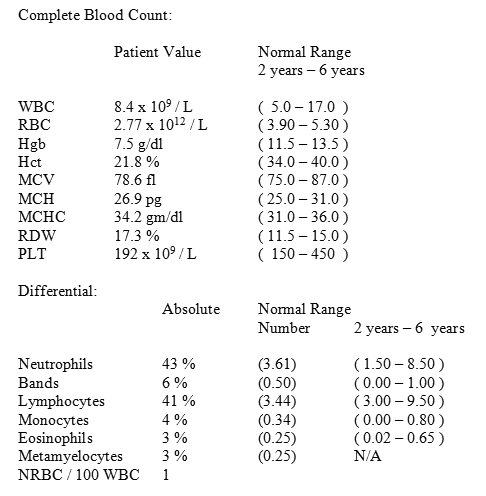
![]() Contributed by Andrew Walls, MD and Lisa Robinson, MD
Contributed by Andrew Walls, MD and Lisa Robinson, MD
![]() Published on line in February 2007
Published on line in February 2007
CLINICAL HISTORY:
This 4-year-old girl presented to the emergency department complaining of fever and pain in the lower extremities with refusal to bear weight. On four occasions a hip x-ray was performed, and she was sent home with pain medications. No laboratory studies were performed. She presented again with the above symptoms and weight loss (weight 13.8 kg, <10th percentile for age.) She was admitted and worked up for possible malignancy. Laboratory studies including a bone marrow biopsy were performed.
PERIPHERAL BLOOD:

A peripheral blood smear was reviewed (Figures 1 and 2) and showed moderate anisopoikilocytosis and polychromasia, with microcytes, fragments, occasional teardrop cells, ovalocytes, rare target cells, and occasional microspherocytes and nucleated red blood cells. The white blood cells showed a neutrophilic left shift, with some neutrophils showing toxic granulation. The platelets appeared adequate in number.
BONE MARROW:
A bone marrow biopsy and aspirate were performed. The aspirates and touch imprints showed clusters and aggregates of cells (Figures 3 and 4), and in some areas a fibrillary background appeared to be present (Figure 5). The cells were small to moderately sized with a high nuclear to cytoplasmic ratio and chromatin that varied from speckled to more blastic in appearance (Figures 6 and 7). Hematopoietic cells of all three lineages were found but were markedly decreased. The biopsy revealed a large portion of the marrow space replaced by necrotic cells (Figures 8 and 9) with some apparently viable small lymphocytes and some fibrosis in these areas. Approximately 25 % of the biopsy contained viable cells. This viable area showed greater than 95 % cellularity and was mostly occupied by an infiltrate of atypical cells with a cohesive growth pattern (Figures 10 and 11). A few hematopoietic precursors were also found in this area. The bony trabeculae were unremarkable.
A limited panel of immunohistochemical stains was performed on the bone marrow biopsy. The atypical cells were negative for CD45 / LCA, CD99, and chromogranin. The same cells were positive for synaptophysin (Figure 12) and weakly positive for protein-gene product 9.5 (PGP 9.5) (Figure 13).
Results of flow cytometric immunophenotypic studies were non-specific.